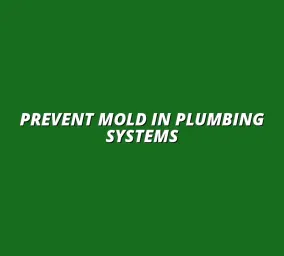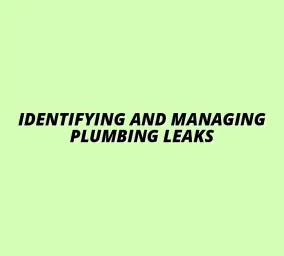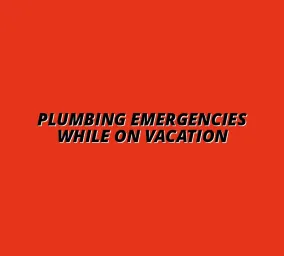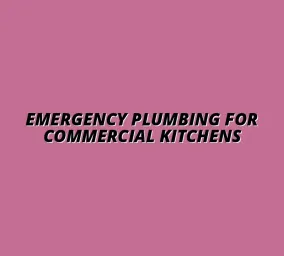Emergency Water Line Repair Tips
Understanding Water Line Emergencies and Their Impact
When it comes to plumbing, a broken water line can create chaos! It can lead to extensive damage in your home, disrupt your daily routine, and even result in costly repairs. Understanding what a broken water line is and its impact can help you act quickly in emergencies.
A broken water line generally refers to a burst or leak in the pipes that supply water to your home. This can happen suddenly, often without much warning, and can be caused by various factors. Knowing the implications of this issue can prepare you to handle it better when it occurs.
What Constitutes a Broken Water Line?
A broken water line is defined as any pipe in your plumbing system that has developed a crack, hole, or complete rupture. This can cause water to leak into your home or yard, leading to flooding and potential water damage. Understanding this concept is vital for homeowners.
There are several types of breaks that can occur. Some common categories include:
- Corrosion-related breaks from aging pipes
- Frost-induced breaks due to extreme cold
- Pressure-related breaks from sudden changes in water pressure
Common Causes of Water Line Breaks During Emergencies
Water line breaks can be triggered by various emergency situations. Common causes include:
- Extreme Weather: Heavy rain or snow can lead to soil erosion, stressing the pipes.
- Ground Shifts: Earthquakes or construction activities can shift the ground, impacting pipe stability.
- Overgrown Tree Roots: Roots can invade pipe systems, causing breaks and clogs.
By recognizing these causes, you'll be more equipped to prevent them from causing damage to your home. For example, preventing frozen pipes during winter is crucial in colder climates.
Signs of a Broken Water Line to Look Out For
Being able to spot the signs of a broken water line can save you from significant damage. Here are some indicators to watch for:
- Unexpected puddles or wet spots in your yard
- Sudden drops in water pressure
- Increased water bills without explanation
If you notice any of these warning signs, it’s essential to take action immediately! A sudden increase in your water bill could point to a leak, especially in areas like the bathroom where leaks can be easily hidden.
Immediate Actions to Take When a Water Line Breaks
Taking swift action during a water line break can significantly mitigate damage. The first step is to shut off the water supply. This will prevent further water from flooding your home and causing additional issues.
It's essential to know how to find your main water shutoff valve and understand how to properly turn it off. This knowledge can save you headaches and potentially thousands of dollars in repairs!
Shutting Off Water Supply: The First Important Step
The *main water shutoff valve* is your best friend when dealing with a plumbing emergency. Finding it quickly can minimize water damage effectively. It is usually located in the basement, near the water meter, or outside the house.
To shut off the water supply, follow these steps:
- Locate the main water shutoff valve.
- Turn the valve clockwise until it stops.
- If the valve is stuck, you might need a wrench for additional leverage.
Locating Your Main Water Shutoff Valve
Knowing where your main water shutoff valve is located can make all the difference during a crisis. Check areas like:
- The basement
- Outside near the foundation
- In the garage or laundry room
Don't wait for an emergency to find it—make a point to locate it today! If a flooded bathroom occurs, quick access to the main shutoff is critical.
How to Properly Shut Off the Water Supply
Shutting off the water supply properly is crucial to prevent further leaks or flooding. Make sure to turn the valve completely until it can't turn anymore. If it’s stuck, gently wiggle it while turning to loosen it up.
Once you’ve shut off the water, check your home for any visible leaks, and prepare to assess the damage!
Assessing the Damage: Evaluating the Severity of the Break
After shutting off the water, the next step is to evaluate the damage. Understanding how severe the break is will help you determine whether you need professional assistance or if you can manage it on your own.
Look for signs like:
- Water pooling on the floor
- Staining on walls or ceilings
- Mold or mildew growth
Identifying Different Types of Water Line Breaks
Not all breaks are created equal! Identifying the type of break can change your response. Types of breaks include:
- Minor leaks that can be temporarily fixed
- Major breaks that require immediate attention
- Obstructed pipes that may lead to backups
If you find a significant break, consider contacting a plumber for help! For quick, temporary fixes, you might try repairing a burst pipe quickly with readily available materials.
Understanding Potential Risks Associated with Pipe Damage
Damage to water lines can lead to a variety of risks, including:
- Structural damage to your home
- Health hazards due to mold
- Increased water bills and waste
Being aware of these risks highlights the importance of acting quickly! For kitchen plumbing emergencies, see managing kitchen plumbing emergencies.
When to Seek Professional Help for Water Line Issues
Knowing when to call in the professionals can make a huge difference during a water line emergency. It’s easy to feel overwhelmed and anxious when faced with a broken water line. However, understanding the signs that you need expert assistance can help you prevent further damage to your home.
Some situations clearly indicate that you should seek professional plumbing services. For example, if you notice significant flooding, persistent water leaks, or if you're unable to locate the source of the problem, it's time to call a plumber. In these cases, expert help can save you time and money in the long run!
Identifying Situations That Require Expert Assistance
There are several signs that indicate it's time to contact a plumbing professional. Ignoring these signals can lead to more severe damage and expensive repairs down the line. Here are some key indicators:
- If the water pressure suddenly drops, it could mean a significant leak.
- Unusual noises coming from pipes, like banging or gurgling, can be a sign of trouble.
- Water stains on walls or ceilings often indicate an underlying plumbing issue.
- If you notice a sudden spike in your water bill without any explanation, it may point to a leak.
Don’t hesitate to reach out for help if you encounter any of these issues. For example, a plumber in Brandwood End, Birmingham can be found at this link. Professional plumbers have the skills and tools needed to assess and resolve complex water line problems.
Signs That Indicate a Need for Professional Plumbing Services
In addition to the previously mentioned signs, there are more specific situations that warrant immediate professional attention. Here are a few:
- Persistent foul odors near water sources could suggest sewage or drainage issues.
- Visible corrosion or rust on pipes can lead to leaks and should not be ignored.
- If you experience low water quality, such as discolored or dirty water, it’s best to consult a plumber.
Recognizing these warning signs early can help you avoid costly repairs and ensure your home remains safe and secure. Issues with your water heater, such as fixing a leaking water heater, often require professional attention.
Cost Considerations for Emergency Plumbing Services
Understanding the costs associated with emergency plumbing services is essential for effective budgeting. While prices can vary based on your location and the severity of the problem, here are some factors that influence costs:
- The time of day: Emergencies during nights or weekends often incur higher rates.
- The complexity of the issue: More complicated repairs will generally cost more.
- Materials needed for the job can also add to the overall expense.
It’s a good idea to get multiple estimates from different plumbers. This will help you make an informed decision while ensuring you receive quality service at a fair price!
Preventive Measures to Avoid Future Water Line Emergencies
Taking steps to prevent water line emergencies can save you a lot of stress and money in the future. Regular maintenance and inspections are essential in keeping your plumbing system in good shape. By following some simple steps, you can ensure your water lines remain functional and healthy!
Establishing a routine for checking your water lines is key. This includes looking for signs of wear, corrosion, or leaks. Catching problems early can prevent more significant issues down the line.
Regular Maintenance Tips for Water Lines
Maintaining your water lines is crucial for preventing emergencies. Here are some effective maintenance tips that can help:
- Inspect pipes for cracks or leaks at least twice a year.
- Flush your water heater annually to remove sediment buildup.
- Check your water pressure to ensure it’s at a safe level.
- Know the location of your main shutoff valve for quick access during emergencies.
By incorporating these tips into your routine, you can extend the life of your water lines and reduce the risk of unexpected breaks!
How to Inspect Your Water Lines Periodically
Regular inspections are an effective way to catch problems before they escalate. Here’s a simple guide on how to inspect your water lines:
- Look for visible leaks or water stains in areas around pipes.
- Check for any unusual noises when turning on faucets or flushing toilets.
- Ensure that any exposed pipes are insulated, especially in colder climates.
- Examine joints and seams for signs of corrosion or wear.
Performing these checks can help you maintain your plumbing system and prevent costly repairs!
Signs of Wear and Tear to Monitor
It’s essential to know what signs of wear and tear to look for in your water lines. This can help you address issues before they lead to emergencies. Here are some signals to keep an eye on:
- Discoloration or rust on pipes.
- Moisture around joints or connections.
- Unexplained increases in your water bill.
- Frequent blockages or slow drainage in sinks and tubs.
Being vigilant about these signs allows you to take swift action, safeguarding your home from emergencies!
Implementing Safety Measures to Mitigate Risks
In addition to regular maintenance, implementing safety measures can greatly reduce the risk of water line emergencies. Homeowners can take proactive steps to protect their plumbing systems. Here are some best practices:
- Keep your yard clear of debris that could block drainage.
- Insulate pipes in unheated areas to prevent freezing.
- Install a sump pump if you live in an area prone to flooding.
- Be cautious with chemicals in your plumbing to prevent corrosion.
Each of these measures can help ensure your plumbing remains in good shape, minimizing the chances of a break!
Creating an Emergency Response Plan for Plumbing Issues
Having an emergency response plan is crucial for any homeowner. Being prepared can make a challenging situation less stressful. Here’s how to create an effective plan:
- Know where your main water shutoff valve is located.
- Keep contact information for a reliable plumber at hand.
- Establish a checklist of what to do in case of a water line break.
- Educate family members about the plan to ensure everyone knows their role.
By preparing in advance, you can respond quickly and effectively if an emergency arises!
Addressing Common Questions Regarding Water Line Emergencies
When it comes to water line emergencies, many homeowners have questions. Understanding these common concerns can provide peace of mind and clarity. Let’s explore some frequently asked questions!
FAQs About Quick Plumbing Fixes for Broken Water Lines
Quick fixes can be a lifesaver in an emergency. However, many people wonder about the effectiveness of these repairs. Here are answers to some common questions:
How Long Can Temporary Fixes Last?
Temporary fixes, like pipe repair tape or epoxy putty, can provide enough time to prevent further damage while waiting for a professional. Typically, these solutions can last a few hours to a few days. However, it's essential to monitor the area closely and have a professional come to make permanent repairs!
What Are the Risks of Ignoring a Broken Water Line?
Ignoring a broken water line can lead to severe consequences. Here are some risks associated with neglecting the issue:
- Increased water bills due to leaks.
- Potential structural damage to your home.
- Risk of mold and mildew growth from excess moisture.
- Health hazards from contaminated water.
Addressing the situation promptly can help you avoid these problems and keep your home safe!
Final Thoughts on Managing Water Line Emergencies
Understanding how to manage water line emergencies is crucial for every homeowner. Quick plumbing fixes and preventive measures can make a significant difference. I hope you feel more prepared to tackle any plumbing issues that may arise!
Summary of Quick Plumbing Fix Strategies
In summary, here are a few quick plumbing fix strategies you can implement:
- Shut off the water supply immediately.
- Use pipe repair tape for temporary sealing.
- Consider epoxy putty for small leaks.
- Assess the situation and call a professional if necessary.
Having these strategies in mind can help you respond effectively to water line emergencies!
Key Takeaways for Homeowners Facing Water Line Breaks
As a homeowner, it’s essential to be proactive about water line issues. Here are some key takeaways:
- Regularly inspect your plumbing system.
- Know when to seek professional help.
- Create an emergency response plan for your household.
- Stay informed about quick fixes and preventive measures.
By following these steps, you can ensure your home remains safe and minimize the risk of plumbing emergencies!
Encouraging Preparedness and Proactive Measures
Preparedness is key to dealing with any emergency, including plumbing issues. Taking proactive measures can greatly reduce stress and damage. I encourage every homeowner to prioritize plumbing safety and maintenance.
Promoting the Importance of Emergency Planning
Emergency planning is vital for ensuring the safety of your home. Being prepared allows you to respond quickly and efficiently. Share your plan with family members and make sure everyone knows what to do in case of a plumbing emergency!
Resources for Further Assistance and Learning
If you want to learn more about managing water line emergencies, many resources are available. Consider visiting local plumbing supply stores or checking online for DIY guides. Many organizations also offer workshops on home maintenance, which can be a great way to stay informed and prepared!






